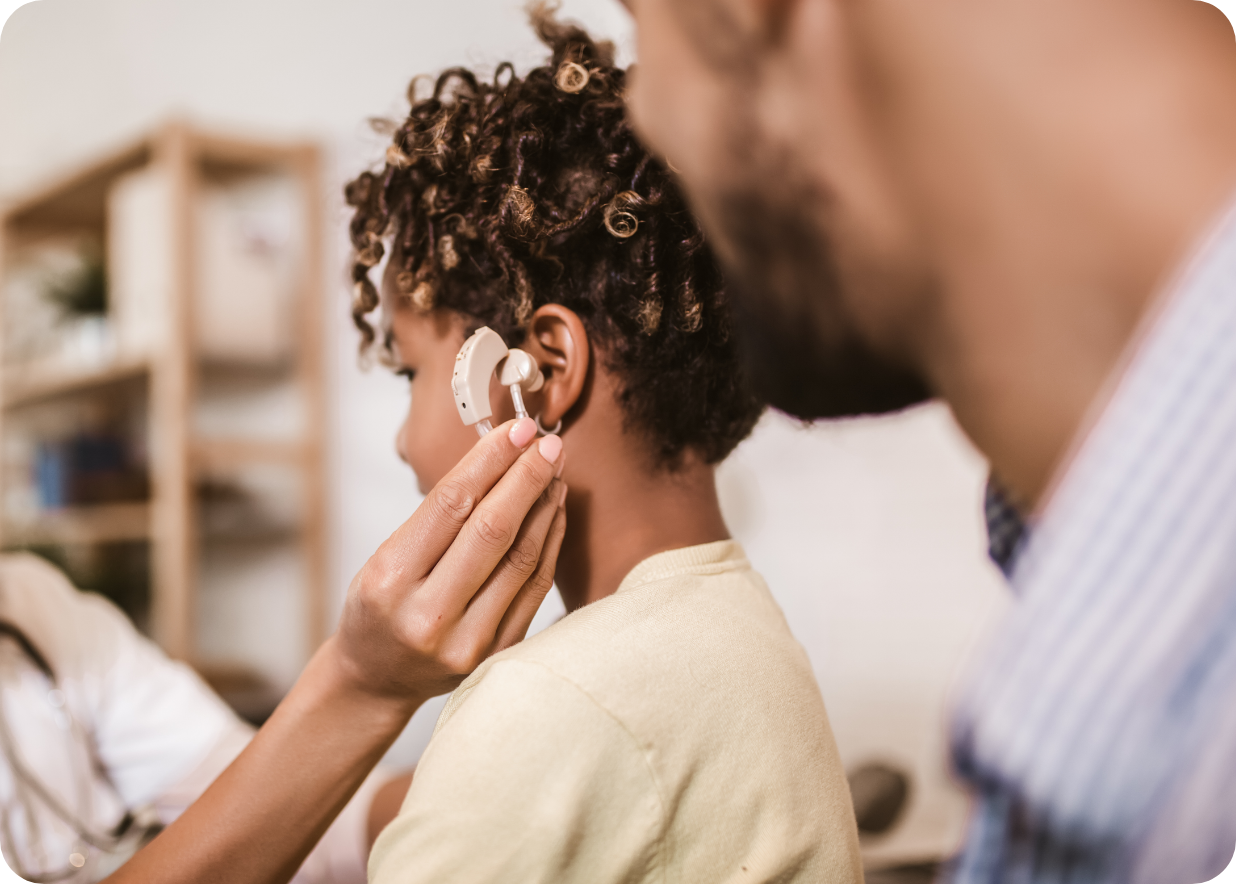ENT
North Bay ENT & Audiology offers a wide variety of ENT services. We treat patients of all ages.

EARS
NOSE
THROAT
HEAD & NECK
EARS
From the voices of your loved ones to the melodies of your favorite songs, your ability to hear connects you to your world in a way no other sense can.
When your ears are giving you trouble due to a hearing difficulty, chronic ear infections, or other ear-related ailments, you can feel isolated from your friends, family, and co-workers, and disconnected from the way you’d like to live your life.
If you or a loved one have an ear or hearing concern, please call one of our convenient locations. We look forward to serving you.
CONDITIONS WE TREAT
Cholesteatomas are abnormal growths of skin tissue within the middle ear, caused by problems such as ear infection.
Conductive hearing loss occurs when disease, trauma, infection, or another problem causes sound waves to travel poorly through the outer ear canal to the eardrum, the middle ear’s three tiny bones, and the inner ear.
Symptoms such as lightheadedness, nausea, blurred vision, and a feeling of unsteadiness may point to dizziness or motion sickness, which involve balance and equilibrium, both controlled by the body’s vestibular system.
Ear pain in one or both ears may be a symptom of otitis media, inflammation of the middle ear. This may be caused by an infection.
Middle-ear infections aren’t unusual in childhood, but sometimes they keep coming back or won’t clear up with antibiotic treatment. They can lead to serious problems such as hearing loss and should be addressed quickly.
Autoimmune inner-ear disease is a rare condition in which the body’s immune system mistakenly attacks normal inner-ear cells as if they were a virus or bacteria. The resultant inflammation causes rapidly progressive hearing loss and includes other symptoms such as tinnitus, balance problems, and the feeling of plugged ears.
Trouble listening amid background noise, following conversations even in small groups, or understanding what’s being said on TV and on the phone can indicate a hearing loss. Most hearing loss can be treated, especially with early detection through regular checkups.
Ear infections may be viral, bacterial, or fungal in nature, and they typically can cause mild temporary hearing loss or — in the case of repeated and untreated infections — more severe or permanent hearing impairment.
Sounds that register 85 decibels or above can damage the inner ear and cause noise-induced hearing loss, one of the most preventable forms of hearing impairment. MP3 players, fireworks, lawn mowers, concerts, and other sources of loud noise can put your hearing at risk, so it’s important to limit exposure, reduce the volume, and wear effective hearing protection.
A perforated eardrum involves a rupture, tear, or hole in the tympanic membrane between the ear canal and middle ear. Causes can include head injury, barotrauma, fluid buildup from infection, a sudden explosive sound, or an object pushed into the ear.
Swimmer’s ear is an outer-ear infection typically caused by bacterial or fungal growth when the skin in the ear canal becomes macerated from activities such as swimming, allowing microbes to infect the ear canal. It can cause pain, fever, temporary hearing loss, and other symptoms but is treatable.
Tinnitus is the perception of ringing, buzzing, humming, clicking, or other sounds in one or both ears that no one else can hear. It’s a symptom of an underlying medical condition, typically hearing loss.
TREATMENT OPTIONS
Ear tubes or tympanostomy tubes are small cylinders surgically inserted in the eardrum to relieve chronic ear infection or persistent middle-ear fluid. Ear-tube insertion is especially common for children.
Hearing aids come in many sizes, styles, features, and capabilities to improve hearing, but it’s important to start with a hearing test. Licensed audiologists — whether independent or on staff at an ENT office — are trained to evaluate hearing, determine the type of hearing loss, and recommend the appropriate hearing technology for your lifestyle and listening needs.
NOSE
Whether you’re experiencing a stuffy nose or a persistent mouth sore, you can rely on our proven years of experience to bring you relief.
A good, deep breath starts with a clear nose and mouth. Whether you’re experiencing a stuffy nose or a persistent mouth sore, you can rely on our proven years of experience to bring you relief.
CONDITIONS WE TREAT
Whether a broken nose, a fractured cheekbone, a swollen eye, or another condition, facial sports injuries can affect your ability to breathe, eat, see, smell, or handle other crucial functions. Safety and protection are key to prevention, but it’s important to seek immediate medical help if injury occurs.
A deviated septum involves displacement of the cartilage wall that divides the nose’s nasal passages, potentially leading to difficulty breathing, facial pain, nosebleeds, chronic sinus infections, and other problems. The condition is typically corrected by surgery.
Sinusitis, a treatable condition, is an inflammation of the sinuses that prevents drainage from occurring properly. Recurring or chronic sinus infections, nasal congestion, sinus headaches, or facial pressure are possible indications of this condition.
Fungal sinusitis, which can occur when the immune system is compromised, involves inflammation of the sinus cavity due to the presence of fungus. Treatment depends on the type of fungal sinusitis involved.
Sinus headaches, caused by inflammation of the air cavities in the head and face, include symptoms such as forehead and facial pain, fever, toothache, congestion, nasal discharge, and facial swelling. They’re often confused with the more common migraine headaches.
Aging brings structural changes to the nose that can lead to sinusitis, an inflammation of the sinuses. Symptoms of sinusitis can overlap with other conditions such as allergic rhinitis, thus consultation with an otolaryngologist may be necessary for diagnosis.
Stuffy nose or nasal decongestion involves the swelling of nasal tissue and blood vessels, which can be caused by allergies, cold viruses, sinus infections, polyps, thyroid disorders, and other sources. Depending on the underlying cause, some home remedies and over-the-counter medication may help resolve the condition, but problems such as persistent symptoms; yellow, green, or bloody nasal discharge; and fever require professional medical consultation.
Tongue-tie or ankyloglossia is a congenital condition involving restriction of the tissue — the frenulum — that links the tongue muscle to the bottom of the mouth.
Mouth sores involve various types of potentially painful oral lesions such as canker sores and cold sores, which can be caused by infection, tobacco use, poor oral hygiene, radiation treatment, stress, dehydration, and other sources.
A nasal fracture or broken nose involves breakage of bone in the nose, which can cause pain, swelling, difficulty breathing, a misshaping of the nose, and other problems. It’s a common injury due to falls, fighting, cycling, and sports, and it requires immediate medical attention.
Nosebleeds, common especially among young children and seniors, result from blood vessels breaking in the nose. Causes range from nose or facial injury, infection, allergies, or medication side effects to dry air or climate, tumors, nose picking or heavy nose blowing, and other sources.
Postnasal drip is the feeling of mucus dribbling from the back of the nose into the throat.
Snoring involves the noisy vibration of tissue in the throat when the airway is narrowed or partially blocked during sleep. Millions of Americans snore during sleep, and many of them may suffer obstructive sleep apnea, a common disorder characterized by interrupted breathing or shallow breaths during sleep.
The temporomandibular joint or TMJ is a triangular cartilage disc that helps facilitate jaw movements such as opening, closing, and chewing. Symptoms such as facial, jaw, or ear pain; difficulty chewing; or locking of the jaw may point to a TMJ disorder requiring medical attention.
TREATMENT OPTIONS
Antihistamines, decongestants, and cold remedies involve various types of over-the-counter medications to treat symptoms of allergies, and upper respiratory infections. Reading the labels, following instructions, and seeking professional advice are crucial to preventing overdose, avoiding harmful side effects, and ensuring the right medication for your symptoms.
Functional endoscopic sinus surgery is typically an outpatient procedure aimed at opening the sinus drainage pathways. It’s a potential option when sinusitis persists or doesn’t adequately respond to other treatments such as medication.
Nose surgery or rhinoplasty is a common procedure to reshape the nose for better breathing or an improved look.
Balloon Sinuplasty is a minimally invasive procedure used by ENT (ear, nose, and throat) specialists to treat chronic sinusitis and relieve symptoms related to sinus blockages. This procedure aims to widen blocked sinus passages using a small, flexible balloon catheter.
Decadron injections are often employed to manage inflammatory conditions affecting the upper respiratory tract or related structures.
THROAT
Your throat plays a vital role in many of your body’s functions: breathing, swallowing, and speaking, just to name a few.
If you begin to have trouble with any of these or other throat-related activities, please contact us. There are a number of reasons such things occur, and seeing a trusted professional will ensure you receive the accurate diagnosis and effective treatment you need to live a more normal life.
Please review the information provided on this site, and don’t hesitate to call our practice to learn more. The earlier we can detect a throat-related difficulty, the earlier we can provide a more effective method of treatment.
CONDITIONS WE TREAT
Voice box cancer or laryngeal cancer refers to the uncontrolled growth of malignant, abnormal cells in the larynx, which is part of the throat and holds the vocal cords.
Nodules, polyps, and cysts comprise the main types of nonmalignant but abnormal tissue growths that can appear around the vocal cords. Hoarseness, uneven or gravelly voice, difficulty speaking, voice fatigue, and other potential symptoms require medical attention for a diagnostic evaluation and treatment.
Tonsillitis — a viral, bacterial, or immunological inflammation of the pharyngeal tonsils at the back of the throat — is especially common in children and may require surgery. Symptoms can range from fever, bad breath, or throat pain to sleep apnea, drooling, difficulty swallowing, or other problems, depending on the type of tonsillitis.
Vocal cord paralysis refers to immobility of the vocal cord muscles, potentially affecting the ability to breathe, swallow, speak, or sing.
Gastroesophageal reflux disease or GERD involves the backflow of stomach acid into the esophagus, with heartburn as the most frequently described symptom. Laryngopharyngeal reflux or LPR results if the stomach acid reaches the throat.
Hoarseness refers to changes in the voice that make it sound gravelly, faint, raspy, or scratchy. There are many potential causes such as infection, smoking, overuse of the voice, laryngopharyngeal reflux, and cancer, so it’s important to seek medical treatment if symptoms persist.
Difficulty swallowing solids and liquids can sometimes be a side effect of neurological injuries such as a stroke or brain tumor but can also be common among other conditions. If you’ve had a laryngectomy, head or neck surgery, vocal cord nodules, or cochlear implants and can’t swallow food or drink as easily as before, rehabilitative therapy can help.
TREATMENT OPTIONS
After a tonsillectomy and adenoidectomy — usually performed to remove chronically problematic tonsils and adenoids — it’s important to control pain, drink plenty of fluids, get bed rest, and go easy on activities for a while. Scabbing and some swelling are normal, but contact the doctor if problems such as a high fever or bleeding occur.
HEAD & NECK
Our teams of Head and Neck specialists are experts in giving you clarity about the state of your health, the severity of your head and neck condition, and the most effective treatments options available for your particular wellness needs.
CONDITIONS WE TREAT
A lump or sore that doesn’t heal, a sore throat that doesn’t go away, difficulty swallowing, or a change or hoarseness in the voice are all possible symptoms of a potentially cancerous head or neck tumor. Early detection is crucial to successful treatment.
Skin cancer refers to the growth of malignant cells in the skin. There are various types of skin cancers, but the three most common are basal cell carcinoma, squamous cell carcinoma, and melanoma.
Bell’s palsy typically involves temporary paralysis on one side of the face, with potential symptoms such as facial weakness, drooping, or stiffness; drooling; jaw pain; and difficulty tasting, smiling, or closing the eye. It’s a rare condition that normally resolves itself, but medication may help with certain symptoms.
Whether a broken nose, a fractured cheekbone, a swollen eye, or another condition, facial sports injuries can affect a child’s ability to breathe, eat, see, smell, or handle other crucial functions. Safety and protection are key to prevention, but it’s important to seek immediate medical help if injury occurs.
Ménière’s disease is an inner-ear disorder that impacts balance and hearing and typically affects people approaching middle age, with onset occurring sometime during their 40s to 60s. It can affect one or both ears and cause symptoms such as extreme dizziness, tinnitus, a feeling of fullness in the ear, and hearing loss.
Disorders of the thyroid gland, an organ crucial to physiological functions such as breathing and maintaining body temperature, largely involve overactive thyroid, or hyperthyroidism; underactive thyroid, or hypothyroidism; enlarged thyroid, or goiter; or cancer.
TREATMENT OPTIONS
Fine needle aspiration (FNA) is a medical procedure used primarily in the diagnosis of lumps or masses in various parts of the body, including those within the head and neck region that an ENT specialist may encounter.
If a skin lesion or condition involves areas near the ears, nose, or throat, an ENT specialist might collaborate with a dermatologist or perform the biopsy if necessary.
Featured Doctors

KATHERINE V. DAY, M.D.
Doctor Ear, Nose & Throat (ENT)

MICHAEL P. RODRIGUES, M.D.
Doctor Ear, Nose & Throat (ENT)

CARLA M. LAWSON, M.D.
Doctor Ear, Nose & Throat (ENT)

New Patients Information
If you are a new patient to the practice or have not been seen in over three years, we kindly ask that you arrive 30 minutes prior to your appointment. The early arrival time allows you to locate the office, allow for parking, and the time needed to fill out any new paperwork. Please bring your insurance cards, photo ID, a list of medications you are currently taking and your co-pay and insurance referral if required.

Existing Patients
Please bring your insurance cards, photo ID, a list of medications you are currently taking and your co-pay and insurance referral if required.
PATIENT INFOHave a question? Reach out any time!
CONTACT US

Katherine V. Day, M.D.
DOCTOR EAR, NOSE & THROAT (ENT)
Dr. Katherine Day, originally from West Virginia, graduated with high honors from Princeton University and with highest honors from Yale University School of Medicine. She completed her residency in otolaryngology at the University of Maryland, where she managed to include prize-winning research with a busy clinical schedule. Dr. Day is board certified by the American Board of Otolaryngology.

